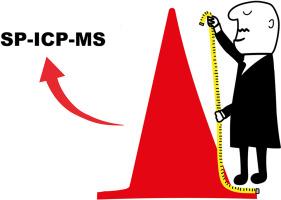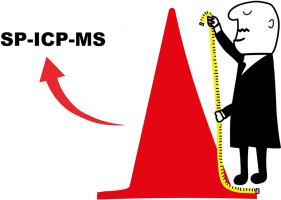利用瞬态事件高度改进单粒子电感耦合等离子体质谱法的检测和质量指标
IF 6
2区 化学
Q1 CHEMISTRY, ANALYTICAL
引用次数: 0
摘要
单粒子电感耦合等离子体质谱(SP-ICP-MS)是表征微颗粒和纳米颗粒材料的有力方法。该技术主要依赖于单个事件的综合强度(峰面积)和分析物质量之间的线性关系,尽管传输时间(峰宽度)也用于定量目的。这项工作(1)评估了在SP-ICP-MS中使用峰高作为分析信号的潜力,(2)介绍了一种确定峰高的新方法,(3)探索了峰高比常用SP-ICP-MS信号提供附加价值的场景。结果提出了一种准确估计SP-ICP-MS峰高的新方法。连续停留时间的累积强度使用三次多项式建模,从中导出调整后的峰高。这种方法减少了与使用原始最大强度值相关的不确定性,产生的NP分布可与通过综合强度获得的分布相媲美。并对停留时间对峰高的影响进行了评价。在50 μs ~ 200 μs范围内,峰高与NP直径的平方呈线性关系。在此范围内,峰高在表征较小的NPs时表现出最低的偏差,表明有可能提高定量限(LoQ)。此外,峰高被证明有助于确定检测限(LoD)和为数据处理设置适当的阈值,从而有助于标记不正确的结果,从而解决SP-ICP-MS分析中的一个挑战。本研究首次将峰高作为SP-ICP-MS分析信号进行评价。结果突出了其在特定应用中的优势,例如在LoD附近确定np大小,以及支持更可靠地使用其他信号(例如峰值区域),帮助识别不正确的阈值选择,从而导致偏倚分布。最后,对峰值高度的监测允许对LoD进行更现实和无假设的确定。本文章由计算机程序翻译,如有差异,请以英文原文为准。


Improving detection and figures of merit in single-particle inductively coupled plasma-mass spectrometry via transient event heights
Background
Single-particle inductively coupled plasma-mass spectrometry (SP-ICP-MS) is a powerful method for characterizing micro- and nanoparticulate materials. The technique primarily relies on the linear relationship between the integrated intensities of individual events (peak areas) and the analyte mass, though transit times (peak widths) have also been used for quantitative purposes. This work (1) evaluates the potential of using peak heights as analytical signals in SP-ICP-MS, (2) introduces a new method for determining peak heights, and (3) explores scenarios in which peak height offers added value over the commonly used SP-ICP-MS signals.
Results
A new method was proposed to estimate peak height values in SP-ICP-MS accurately. The cumulative intensity across consecutive dwell times was modeled using a third-degree polynomial, from which the adjusted peak height was derived. This approach reduces the uncertainty associated with using raw maximum intensity values, yielding NP distributions comparable to those obtained via integrated intensities. The effect of dwell time on peak height was also evaluated. An optimal range (50 μs–200 μs) was identified, where a linear relationship was observed between the peak height and the square of the NP diameter. Within this range, peak height showed the lowest bias when characterizing smaller NPs, indicating the potential to improve the limit of quantification (LoQ). Additionally, peak heights proved helpful in determining the limit of detection (LoD) and setting appropriate threshold values for data processing, thereby helping to flag incorrect resultsand addressing a challenge in SP-ICP-MS analysis.
Significance
This is the first study to evaluate peak height as an analytical signal in SP-ICP-MS. The results highlight its advantages in specific applications, such as sizing NPs near the LoD, and in supporting the more reliable use of other signals, such as peak areas, by helping to identify incorrect threshold selection that could lead to biased distributions. Finally, monitoring peak heights allows for a more realistic and assumption-free determination of the LoD.
求助全文
通过发布文献求助,成功后即可免费获取论文全文。
去求助
来源期刊

Analytica Chimica Acta
化学-分析化学
CiteScore
10.40
自引率
6.50%
发文量
1081
审稿时长
38 days
期刊介绍:
Analytica Chimica Acta has an open access mirror journal Analytica Chimica Acta: X, sharing the same aims and scope, editorial team, submission system and rigorous peer review.
Analytica Chimica Acta provides a forum for the rapid publication of original research, and critical, comprehensive reviews dealing with all aspects of fundamental and applied modern analytical chemistry. The journal welcomes the submission of research papers which report studies concerning the development of new and significant analytical methodologies. In determining the suitability of submitted articles for publication, particular scrutiny will be placed on the degree of novelty and impact of the research and the extent to which it adds to the existing body of knowledge in analytical chemistry.
 求助内容:
求助内容: 应助结果提醒方式:
应助结果提醒方式:


